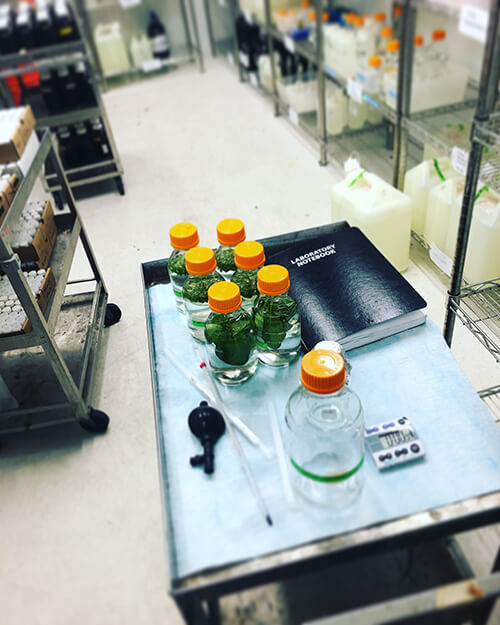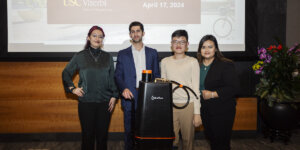
“In Jamaica, the presence of water is a lifeforce” -Assistant Professor Adam Simpson
If there’s one thing Adam Simpson loves as much as research, it’s cooking.
“The kitchen isn’t so different from the lab,” he reflects. “Cooking is an art form, and there’s an art to lab work. When building the layers of a stir fry or a curry, you have to be aware that the vegetables achieve their peak flavor and texture at different rates, applying the same degree of procedural knowledge as you would when following a lab experiment.”
Remembering growing up in Kingston, Jamaica, Simpson (who now follows a plant-based diet) rhapsodizes on the delights of ackee and saltfish, oxtails, fried dumplings and his aunt’s famous roast chicken. In fact, he once aspired to be a chef, inspired by TV gourmands such as Alton Brown and the scientific rigors of Michelin star restaurants.
However, his family history led him in a different direction. “I originally entered the field of environmental engineering because I was interested in water treatment,” Simpson explains. “Generations of my family have been associated with water. My grandfather was an engineer who founded what became the primary well-drilling company in Jamaica, still run by my parents. They also manage a subsidiary that sells clean, potable water as well as processed water primarily for food manufacturing.
“In Jamaica, the presence of water is a lifeforce – waterfalls, caves, underground rivers… It’s a limestone island, born from the build-up of porous coral, and so a lot of our freshwater is underground. It’s a beautiful sight to see water pumped out of the ground to share and provide.”
Back to the source
The elemental necessities of food and water have since become the defining factors of Simpson’s outlook and research. “As a graduate student at Stanford, I initially wanted to study water treatment technologies,” said Simpson. “Research into contaminants and disinfectant byproducts in water is already an established field of study, dating back to the 1970s when analytical chemists discovered toxic compounds like trihalomethanes and haloacetic acids in our piped water.”
The strength of this research – advanced at USC by CEE researchers including Amy Childress, Adam Smith and Daniel McCurry, who work alongside Simpson at the USC ReWater Center – provides the foundation for the comparatively overlooked area of study that Simpson is now determined to bring to the attention of policy makers and the general public: the presence of potentially toxic contaminants in food.
“The Simpson Lab specializes in using environmental engineering principles to examine harmful chemicals in processed food,” he said. “We examine food disinfection and processing techniques to understand how these treatments manipulate and transform the solid matrices and chemistry of nutrients, resulting in the formation of potentially toxic contaminants.”

Experiment in The Simpson Lab to test for the formation of toxic contaminants in spinach during chlorine disinfection
The fields of environmental science and engineering have tended to focus on pollutants in air and water rather than food. As a result, several of these toxic compounds have not been studied before, and Simpson is at the forefront of a new generation of researchers who are changing the way contamination is studied.
“In an environmental context, we typically think about toxic contaminants in terms of discrete chemicals,” he explained. “It’s easy to visualize solo molecules that dissolve into water or attach themselves to the surface of food. However, I’m studying how a leaf of processed spinach, for instance, might form chemically bound toxic compounds that are only liberated through digestion.”
We are what we eat
Simpson comes from a lineage of individuals who have sought to dig deeper to discover new founts of knowledge. Growing up in a developing country has given him a keen awareness of the injustices inherent in the way resources are distributed; just as not all families can afford to have water pumped directly into their homes, not all householders can afford to buy fresh organic produce.
“I’m trained as an environmental organic chemist and analytical chemist, but I’m discovering that my way of thinking increasingly aligns with environmental justice scholars. Processed foods are almost impossible to avoid as we go about our day – only a small subsection of society can afford to shop at high-end groceries and farmers markets, and don’t need to worry about throwing away food that has spoiled. There’s a clear association between unhealthy, highly processed foods and socio-economic status, and I consider this an environmental justice issue.”
Simpson points to the fact that epidemiologists have identified a correlation between processed food and morbidities like diabetes and high cholesterol. His goal is to reveal whether the root cause of these conditions can be linked to contaminant build-up at the level of the chemical makeup of the food we consume – and whether those contaminants are the byproducts of methods of processing.
The stakes of the data
Given that this is a comparatively emerging field, Simpson’s priority is to establish a firm foundation of scientific data. Next, he hopes to branch out into community-based participatory research methods, learning directly from those who are impacted by food access inequities, and disseminating that new knowledge to influence policies developed by lawmakers and nonprofit organizations. As a fellow of the NSF-funded RECIPES x Black in Engineering program, Simpson is among 40 researchers and 14 institutions working to advance the science that will enable sustainability across the food system.
“Government funding of the National Science Foundation amounts to 20% of that allotted to the National Institute of Health,” said Simpson. “The prevailing approach is about mitigating disease by developing new medications rather than pursuing preventative measures – ensuring that all people have access to the healthy foods, green spaces and clean water that are necessary for survival.”
Simpson sees that emphasis on “after effects” played out in the dynamic between engineering and industry. “Too often, environmental engineering is associated with fixing the problems and pollutants caused by industry,” he argues. “I’m hoping that my area of research will break that trend. If the evidence we produce can be used to assist food processing companies with lowering the risk of generating toxic compounds, engineers can be associated with the profit motivation – rather than merely called in to clear up the damage.”
The stakes are high and the rewards are great. As the impending impacts of the environmental crisis prompt new experiments in processed and imitation foods, Simpson’s research is all the more crucial. His work is oriented toward our long-term future, and it all leads back to the source. The rivers, the waterfalls, the wells, the fresh water – and the nourishing food that he associates with family.
Published on December 13th, 2023
Last updated on February 6th, 2024











